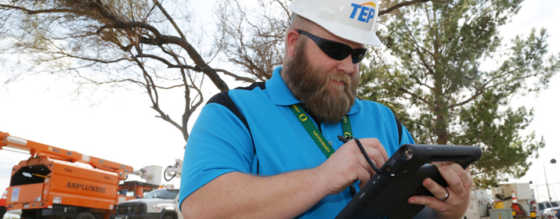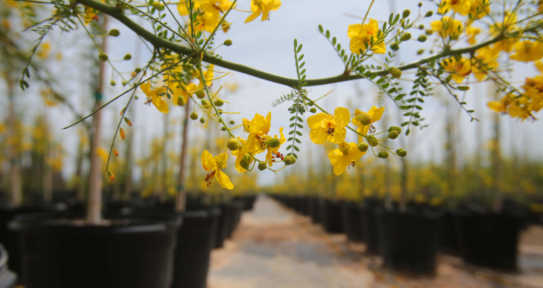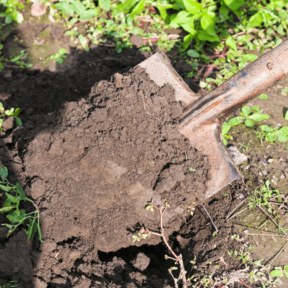Vegetation management
You can help TEP clear the way for reliable service.
While trees and other vegetation are an important part of a clean, safe and healthy community, they also can grow near power lines and other electrical equipment. Help us to maintain reliable service and prevent safety hazards by planting the right tree in the right place outside your home or business.
How can vegetation affect electrical service?
When trees and other vegetation grow too close to power lines and other electrical equipment, they can cause power outages and other safety hazards for our customers.
Potential problems include:
Power outages
Trees that have been planted near power poles can grow so high that that limbs can interfere with power lines and other equipment. During summer monsoons, strong winds and rain can break off branches or topple entire trees. The debris can damage power lines and power poles, causing costly outages that can affect thousands of customers.
Safety issues
Fallen power lines may still be energized,which can present a safety hazard on roadways and nearby pedestrians. If you see a downed power line,stay away from it and call 911.
Low voltage
Electric current is always looking for a way to get to the ground, and vegetation can provide a convenient path. This can result in low voltage to your home or an entire electrical circuit serving hundreds or thousands of customers. Low voltage can damage appliances and other sensitive electronics in your home or business.
Who is the contact for vegetation overgrowth on power lines or other TEP equipment?
- Contact TEP at 520-623-7711 for vegetation management questions or concerns.
- Never attempt to clear vegetation near energized electrical lines!
What does TEP do for the environment in regards to trees?
Trees and other vegetation are an important part of a clean, safe and healthy community. Trees remove carbon dioxide from the air, provide habitat for birds and other wildlife and add beauty to our environment.
That's why TEP has an urban forestry shade trees program. The Trees for You program is designed to help you reduce your energy consumption by planting shade trees.
What does TEP do with all the tree trimmings?
TEP works with partners to transform trimmings generated through our vegetation management program into high-quality compost used to grow new trees through an innovative green waste recycling partnership with Civano Plant Farm and Nursery.
TEP provides the nursery with land at our H. Wilson Sundt Generating Station as well as power, run-off water and more than 400 tons of green waste that are removed annually from power line corridors - material that otherwise would be discarded in landfills.
Nursery employees mulch the material and employ a composting process to create a high quality compost used as planting soil on 50 acres of cultivated land at the Civano Plant Farm on Old Nogales Highway in Tucson.
How often does TEP trim trees and other vegetation?
TEP's certified arborists work with Asplundh Tree Expert Company year-round to identify trees and other vegetation that are in danger of interfering with overhead equipment.
Line clearance crews will clear vegetation from public property and right-of-ways once every six years. More frequent pruning may be required in some circumstances.
Crews also prune vegetation growing on private property away from overhead distribution lines once every six years at no cost to the property owner. A property owner may be billed if tree trimming crews are required to return within six years for additional work.
Download information to learn more about how TEP determines where to trim vegetation.
Crews may need to enter private property to complete this work. For planned trimming, TEP crews make a good-faith effort to notify nearby residents in advance of the work, although that might not be the case in some urgent situations.
How does TEP trim trees?
Our certified arborists and Asplundh Tree Expert Company's experienced crews strive to prune only when absolutely
necessary.
TEP tree trimmers use a technique called "directional" or "lateral" pruning, which has been approved by the United States Forest Service, the National Arbor Day Foundation and other arbor organizations. This technique is used to remove only those limbs that
have the potential to grow into and interfere with electrical equipment.
Download information to learn more about how TEP prunes trees that interfere with overhead lines.
Can TEP "round over" a tree?
TEP does not "round over" branches or use "topping" techniques, which can cause fast-growing sprouts that interfere with
electrical equipment. These techniques can also weaken the tree. When trees are planted directly beneath power lines, branches must be cut back. Our pruning methods will help direct the tree's canopy to grow away from overhead equipment.
This method of pruning, while healthier for the tree than other methods, may result in plants that appear to be out of symmetry.
Alternatives to pruning or cutting down trees, including running lines underground or altering the routes of power lines, may be available at the request and expense of customers.
Will TEP clear vegetation on my property from the power line that connects to my property?
Customers are responsible for clearing vegetation from electric service lines that connect their home or business to our local distribution lines.
Customers who wish to clear away vegetation themselves should first call TEP's Customer Care Center at 520-623-7711 to temporarily suspend service so that this work can be safely completed. There is no cost for this temporary suspension of electric service.
What can I do to help prevent problems caused by vegetation?
You can help us maintain reliable service by making sure to plant the right tree in the right place outside your home or business. To avoid these problems, vegetation should be kept at least 10 feet away from overhead electrical equipment.
Learn more about trees suited for desert climate.
View a diagram on tree planting.
How do I decide where to plant my tree?
Whether you're planting trees for beauty or to create shade that can help reduce your energy usage, here are some thoughts to consider before you break ground.
Know Your Tree
Do you know how tall your new tree might grow? Do you know how wide the canopy might be? Do you know what shape the canopy will take?
It's important to know the answers to these questions when choosing what kind of tree to plant. While certain trees may have specific needs at the time of planting,it's important to envision what that tree will look like in 10 years.
Look Around
Trees grow upward and outward. Are there power lines or other electrical facilities overhead? When the tree reaches maturity, might its canopy make contact with electric lines? Are you planting near any underground equipment?
Trees should be planted so that no part of the tree will ever come within 10 feet of electrical equipment. Trees may need to be positioned near a home to provide shade. Be cautious and remember that potential benefits should be weighed against potential problems in the future.
Before You Dig
Picking up a shovel before you pick up the phone can lead to unnecessary injuries, property damage and damaged underground electrical equipment that can cause power outages.
Before you dig a site for a new tree, call 811, 1-800-STAKE-IT (1-800-782-5348) or visit arizona811.com at least two working days before you dig so that underground facilities can be marked. TEP will locate company-owned service lines at no charge.



